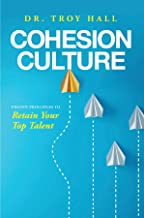By William Carmichael
The word “cohesion” has such a positive overtone. For example, with objects it implies a state of bonding or of things sticking together. For people, of working well together. For groups, of being in close agreement and for organizations, of forming a united whole. And never has the need for a cohesive culture been greater for organizational leaders. In Cohesion Culture: Proven Principles to Retain Your Top Talent, Dr. Troy Hall successfully makes the case that by “creating Cohesion Cultures in workplaces has a positive impact on performance in all developing states of a group, and that retaining talent through a culture of belonging, value, and commitment, rather than replacing old talent with new talent, is essential for an organization’s survival and growth.” I cannot think of a timelier message for leaders concerned with retaining talent they worked so hard to bring in!
Isn’t Cohesion Culture an Engaged Workforce?
In Cohesion Culture’s Introduction, Dr. Hall dispels a widely-held misconception; that employee engagement should be what we as leaders should be striving for. True, as our author will attest, engagement “is the outcome of a team working cohesively within a culture of belonging, value, and commitment,” it is still a singular outcome. What is missing is the “mindset of cohesion,” whereby, “an employee who is engaged through cohesion feels a strong, often unbreakable community bond with his team and the organization.” Interestingly, those in HR, those we might consider best aligned with the cultural needs of their organization too often misconstrue employee engagement as true cohesiveness, when in fact, are two entirely different concepts. Here, employee engagement represents a means to an end while cohesiveness represents shared values, vision, and commitment; what Dr. Hall refers to as the “employees’ sense of belonging.” Another misconception the author brings to our attention deals with incentives. Here, the author makes a convincing point that providing certain “perks,” regardless of their creative intent, is no longer the go-to strategy to keep employees motivated. Monetary or not, these perquisites too often become unintended distractions.
Key Takeaways
In Cohesion Culture, Dr. Troy offers readers as many clues as possible as to what a Cohesion Culture looks like, how it sounds and what actions need to happen to get it right. As in the previous paragraph, he explores topics like engagement, authenticity, and mindset to provide clarity to the leadership and employee base relative to coaching, performance, and development. In the book, he shares the Talent Retention Model™ that is the result of the Cohesion Culture he and his team at South Carolina Federal Credit Union created, which led to national recognition as “Best Places to Work.”
As a former HR practitioner, I found this book to be an extremely effective HR field guide where readers will discover:
- The #1 mistake leaders make when it comes to talent retention
- What a Cohesion Culture is and how can it help you retain your top talent
- How the Talent Retention Model™ can help build a Cohesion Culture™
- Creating a Cohesion Culture™ is essential for long-term business success
- Transformative leadership—those who focus on the needs of others and build goal achievement first through relationship then task
Early in the book, the author uses the analogy of Cohesion Culture as the framework found in a movie or play where leaders, just as employees, have a role to play. In Act One (Chapters 1 & 2), Dr. Troy discusses the three elements of a Cohesion Culture, how to inspire others to “be the leader,” and why engagement isn’t enough to retain your top talent. In Act Two (Chapters 3 & 4), he explains how a Cohesion Culture directly impacts productivity and what it looks like in your organization. He then provides the proven principles to build a Cohesion Culture. Finally, Act Three (Chapters 4 & 5) introduces the Talent Retention Model that is a result of the Cohesion Culture that was built at his former employer.
I found the section on self-development for confident leaders to be particularly helpful, as it contains different theories that allow for diversification depending on personality types. In whole or in part, every paragraph of the work has value and is produced with high-quality cohesive prose and an inspirational atmosphere in its lexical choices. Overall, Cohesion Culture makes convincing arguments for its positive and transformative model and will give fantastic new ideas to any leader or manager looking to create positive changes.
Structure and Layout
Throughout the six short chapters, the author shows readers what a cohesion culture looks like, how it sounds, and what actions need to happen to get it right. Each of the chapters begins with a core concept with which readers will become familiar and ends with a summary of lessons learned. Introductory chapters provide readers a map of leadership patterns and protocols. In these, to delineate what’s expected of leaders before they consider cohesion and retention, Dr. Hall articulate values that encourage cohesion as well as mindsets that embolden leaders to commit to their employees’ individual success, which is the key to cohesion. Subsequent chapters center on team dynamics and workplace strategies. In the final section, he provides the specifics on how to execute the talent retention model, its global impacts, and how cohesion generates employee retention.
Who Will Benefit Most from This Book?
Organizational leaders at all levels, Human Resource professionals
About the author:
Dr. Troy Hall is an expert in talent retention with a doctorate in Global Leadership & Entrepreneurship. As Chief Strategy Officer for South Carolina Federal Credit Union, he has traveled globally speaking with C-Level Executives, Chief Culture Officers and HR professionals on how to build an organizational culture utilizing the Talent Retention Model.

